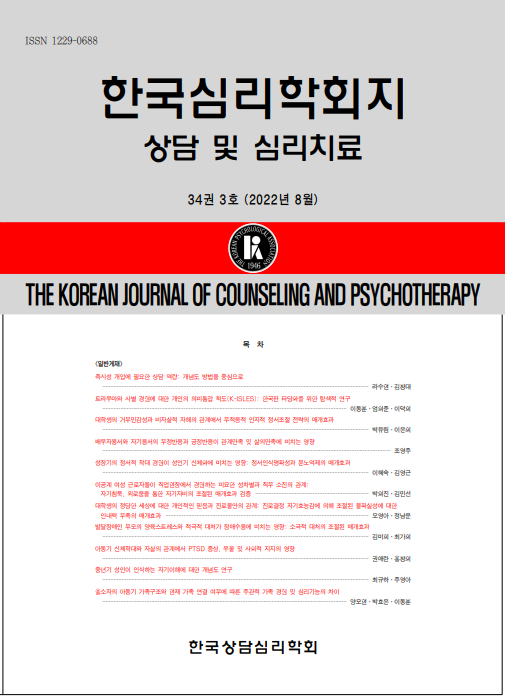open access
메뉴
open access
메뉴 ISSN : 1229-0688
ISSN : 1229-0688
동기조절은 자기조절학습에 중요한 영향을 미치는 요인이지만, 아직까지 척도에 대한 연구가 매우 부족한 실정이다. 이에 본 연구에서는 현재까지 개발되어 사용되고 있는 척도 가운데 가장 다양한 동기조절전략 요인들을 포함하고 있는 Schwinger, von der Laden와 Spinath(2007)의 동기조절전략척도를 토대로, 연구자가 새로운 문항을 추가하여 학습동기조절전략 예비척도를 구성하여 이 척도의 요인구조와 신뢰도, 타당도를 검토하고자 하였다. 서울지역 고등학교 2, 3학년생 281명을 대상으로 척도의 요인구조를 살펴본 결과, 30문항 7요인(흥미/의미증진, 수행접근 자기지시, 환경통제, 자기결과조치, 숙달 자기지시, 수행회피 자기지시, 근접목표설정)으로 나타났으며, 7개 요인은 전체변량의 약 66%를 설명하였다. 학습동기조절전략 척도의 내적 일치도와 문항-총점 간 상관계수는 만족할만한 신뢰도를 나타냈고, 박병기, 전기수, 김선미와 이종욱(2005)이 개발한 동기조절척도와 유의한 정적 상관을 보여 적절한 수준의 수렴타당도를 지닌 것으로 확인되었다. 또한 학업 성취도에 따라 학생들이 사용하는 동기조절전략에서의 차이를 검토한 결과, 성적이 높은 학생들이 대체로 동기조절전략을 유의하게 많이 사용함으로써 적절한 변별타당도를 지닌 것으로 확인되었다. 마지막으로 본 연구의 의의와 제한점에 대해 논의하였다.
Although a motivational regulation strategy was considered as one of the important aspects of self-regulated learning, only few studies have been done. The current study aimed to develop learning motivational regulation strategies inventory and examine its reliability and validity. Given the 30-items scale about motivational regulation strategy developed by Schwinger et al.,(2007), the five new items were added to the preliminary inventory. Factor analysis on responses from 281 high-school students revealed that seven factors (i.e., enhancement of interest/personal significance, performance-approach self-talk, environmental control, self-consequating, mastery self-talk, performance-avoidance self-talk, proximal goal setting) would explained the inter-correlations among 30 items. Specifically, the seven-factor solution explained about 66% of total variance. The 30-item scale exhibited satisfactory internal consistency and item-total correlations. It was positively correlated with Park's(2005) scale and significant differences were found depending on academic performance, demonstrating convergent and discriminant validity, respectively. The implication and limitations of this study are discussed.
김만권, 이기학 (2003). 자기조절학습전략 프로그램이 학업성취와 심리적 특성에 미치는 효과. 한국심리학회지: 상담 및 심리치료, 15(3), 491-504.
김영채 (1990). 학업수행과 결합되어 있는 동기 및 학습전략변인. 계명행동과학, 3(1), 15-38.
김은영 (2008). 여자대학생의 학업성취도에 따른 동기조절전략 연구. 교육심리연구, 22(1), 111-127.
박병기, 전기수, 김선미, 이종욱 (2005). 자기조절학습의 복합적 측정도구 개발과 타당화: 동기조절 척도의 통합을 중심으로. 교육심리연구, 19(2), 455-476.
박승호 (2003). 자기조절학습의 발달을 위한 동기적 요인의 역할. 교육심리연구, 17(1), 55-70.
박승호, 서은희 (2008). 청소년의 자기조절학습: 현황과 교육적 함의. 한국심리학회지: 사회문제, 14(1), 135-152.
배병훈, 신희천 (2009). 자기결정성과 학업 꾸물거림이 학업 스트레스에 미치는 영향: 다변량 잠재성장모형을 이용한 종단분석. 한국심리학회지: 상담 및 심리치료, 21(3), 747-765.
양명희 (2000). 자기조절학습의 모형 탐색과 타당화 연구. 서울대학교 박사학위논문.
양명희, 오종철 (2006). 2x2 성취목표지향성과 자기조절학습과의 관련성 검토. 교육심리연구, 20(3), 745-764.
양병화 (2006). 다변량 데이터 분석법의 이해. 서울: 커뮤니케이션 북스.
이민희 (2009). 자기결정이론을 토대로 한 학습상담전략 탐색. 한국심리학회지: 상담 및 심리치료, 21(3), 703-721.
정미경 (2003). 초등학생용 자기조절학습 검사의 표준화. 초등교육연구, 16(1), 253-272.
조은문, 이종연 (2010). 중학생의 동기조절전략과 자기결정동기 및 학업성취의 관계. 한국심리학회지: 학교, 7(3), 405-428.
한순미 (2004). 학습동기 변수들과 인지전략 및 학업성취간의 관계. 교육심리연구, 18(1), 329-350.
Baumert, J., Fend, H., O’Neil, H. F., & Peschar, J. L. (1998). Prepared for life-long learning[Frame of reference for the measurement of self-regulated learning as a cross-curricular competency in the PISA project]. Paris: OECD.
Boekaerts, M. (1995). Self-regulated Learning at the junction of cognition and motivation. Educational Psychologist, 1, 100-112.
Bouffard-Bouchard, T., Parent, S., & Larivee, S. (1993). Self-regulation on a concept-formation task among average and gifted students. Journal of Experimental Child Psychology, 56, 115-134.
Corno, L., & Mandinach, E. B. (1983). The role of cognitive engagement in classroom learning and motivation. Educational Psychologist, 18, 88-108.
Linder, R. W., & Harris, B. R. (1992). The development and evaluation of a self-regulated learning inventory and its implications for instructor-independent instruction. (ERIC Document Reproduction Service No. ED348010).
Pintrinch, P. R., & DeGroot, E. V. (1990). Motivational and self-regulated learning components of classroom academic performance. Journal of Educational Psychology, 82, 33-40.
Pintrich, P. R., Smith, D. A. F., Garcia, T., & Mc Kearchie, W. J. (1993). Reliability and predictive validity of the motivated strategies for learning questionnaire. Educational and Psychological Measurement, 53, 801-813.
Schwinger, M., von der Laden, T., & Spinath, B. (2007). Strategien zur Motivations regulation und ihre Erfassung[Motivational regulation strategies and their measurement]. Zeitschrift fur Entwicklungspsychologie und Padagogische Psychologie, 39, 57-69.
Schwinger, M., Steinmary, R., & Spinath, B. (2009). How do motivational regulation strategies affect achievement: Mediated by effort management and moderated by intelligence. Learning and Individual Differences, 19, 621-627.
Vallerand, R. J., Pelletier, L. G., Blais, M. R., Briere, N. M., Senecal, C., & Vallieres, E. F. (1992). The academic motivation scale: A measure of intrinsic, extrinsic, and amotivation in education. Educational and Psychological Measurement, 52, 1003-1017.
Wolters, C. A. (1998). Self-regulated learning and college students’ regulation of motivation. Journal of Educational Psychology, 90, 224-235.
Wolters, C. A. (1999). The relation between high school students’ motivational regulation and their use of learning strategies, effort, and classroom performance. Learning and Individual Differences, 11, 281-299.
